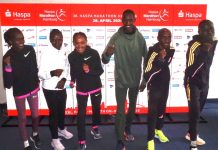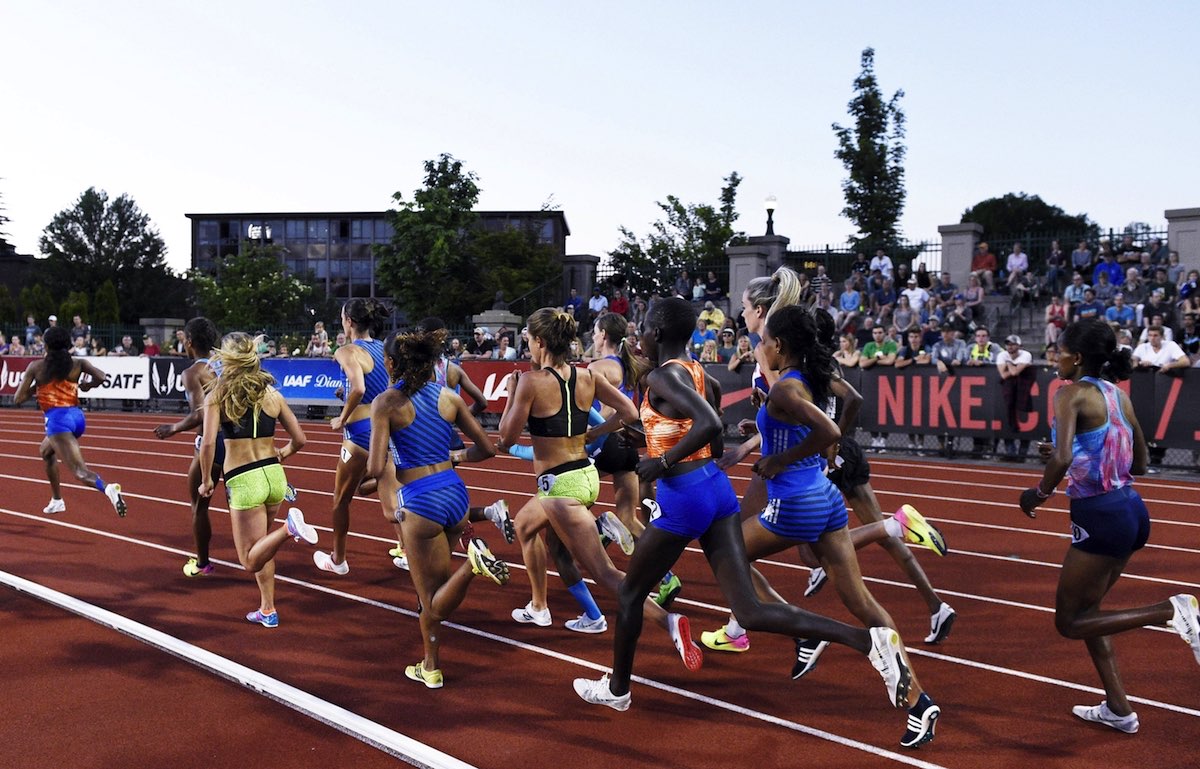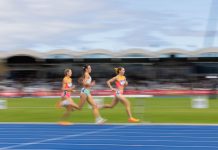I’ll never get to see Hayward Field, or the Hayward Field of my vicarious memory, at least. If I get there for the 2021 world championships it will be to a totally new facility. No stomping feet on the wooden steps of the famous East Stand.
For those of us who came to distance running maturity in the 1970s, Hayward Field was one of those venues which could truly be described as iconic. Like Bislett Stadium in Oslo, where Ron Clarke ran his world record 27:38.4; or the Stockholm 1912 Olympic Stadium, where he ran 13:16.6 for 5000, another world record; or London’s White City, venue for the 1908 Olympic Games, where he won a magnificent surging three mile race against Gerry Lindgren in 12:52.4 for yet another world mark.
Eugene’s Hayward Field had the same sort of emotional pull. It was the home track of Steve Prefontaine who set its historic East Stand rocking time after time, the fans pounding their feet on its wooden floor, as he charismatically assailed all-comers at any distance from one to six miles (this is America we’re talking about, a nation which remains wedded to the imperial distances even now).
Just as many Australians knew Ron Clarke as ‘Clarkie’, to his legions of fans Steve Prefontaine was simply ‘Pre’. And they were Pre’s People.
One of my Glenhuntly clubmates, Eric Sigmont, features in one of the most famous pictures taken at Hayward Field. It is, as ever, a Prefontaine race which he leads from Frank Shorter, in his trademark candy-striped running shorts, Norway’s Knut Kvalheim and Don Kardong, as fluent a writer as he was a distance runner. Sigmont is there, too.
Closing a 10-metre gap in the final back-straight, Prefontaine overhauled Shorter to win in 12:51.4, an American record, less than four seconds off the world record set by Emiel Puttemans en route to his 5000 world record of 13:13.0.
The 3-miles was part of the Hayward Field Restoration meeting, held to mark the completion of a renovation to the West Grandstand.
It was a renovation then, but 45 years on this time it is for keeps. Hayward Field is to be completely re-vamped for the world championships. As soon as the 2018 NCAA championships concluded last weekend (9 June), the ‘renovators’ moved in. On current plans – which are being fiercely contested – the East stand goes, as does everything else, to be replaced by a horseshoe-shaped modern stadium. It may still be called Hayward Field, but it will be nothing like Hayward Field as it has been known till now.
If you want to know more about the controversy, just enter Hayward Field reconstruction into your search engine and watch your screen explode. It might be an idea to don protective glasses.
The makeover for the world championships, however, is not the reason for wondering what is the deal with Hayward Field. Rather, it is something I have been pondering for several years now. The history of Hayward Field, particularly as most of us outsiders know it, is centred around distance running. The legendary Bill Bowerman coached there, succeeded by his protégé, Bill Dellinger. Alberto Salazar was a University of Oregon distance runner: he won his first New York marathon in his Ducks singlet.
Australian involvement is also tilted strongly towards middle and long-distance runners. Jim Bailey was a student at Oregon when he sensationally beat John Landy over the mile at the Los Angeles Coliseum in 1956. Zoe Buckman went to the U of O. Craig Mottram ran one of his best races at the Pre Classic, destroying a top field over two miles in 2007 in 8:03.50, which still ranks his third all-time at the distance behind Daniel Komen and Haile Gebrselassie.
McKenzie Little broke the mould when she won the women’s javelin at this year’s NCAA champs, but the tradition was maintained by Oliver Hoare and Jessica Hull (also at UO) with their 1500 victories.
At the same time, though, Eugene has become Sprint City, typified by Andre de Grasse’s wind assisted sprint double in 2015 when he ran 9.75w to win the 100 and 19.58w to complete the double. There have been no less than 11 sub-9.80 performances over 100 metres at Hayward in recent years: 10 were wind-assisted, admittedly, but most of these would have been sub-10, at least, under legal conditions.
The sensational sprint times continued at this year’s NCAAs, despite weather that could best be described as awful the day most of the men’s finals were run and atrocious the next day for the women’s finals.
Twenty-year-old Rai Benjamin, from Antigua & Barbuda, won the 400 hurdles in 47.02, jumping into equal second on the world all-time list alongside all-time legend Edwin Moses and 0.24 behind Kevin Young’s hitherto-unapproachable world record 46.78 set at the 1992 Olympics. Another 20-year-old, Michael Norman, leapt into sixth place all-time when he won the men’s 400 in 43.61. The University of Houston men’s 4×100 – coached by Carl Lewis and anchored by Cameron Burrell, son of former world record holder Leroy – ran 38.17.
That, as I say, was on the ‘awful’ day. On ‘atrocious’ day, 19-year-old Lynna Irby splashed her way to a 49.80 win in the women’s 400, among other top performances. It was cold. It was wet. It was windy, and still they ran fast.
In recent years, performances in the sprints and field events at the Diamond League Pre Classic have been at least as impressive as the distance races.
The performances across the board, of course, have been helped by the fact that Eugene has hosted most of the recent NCAA and national championship meetings while Nike money has poured into the Pre meeting.
Maybe Eugene track and field fans won’t miss the old East stand as much as they imagine. After all, you can’t stomp your feet too many times in just under 50 seconds.





























